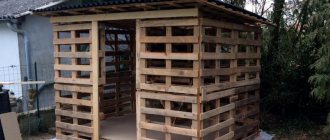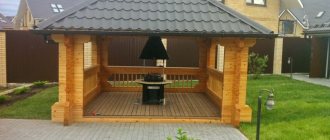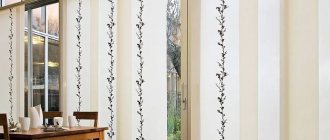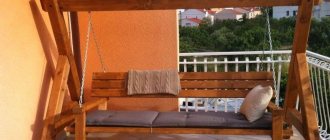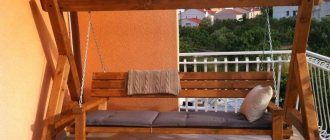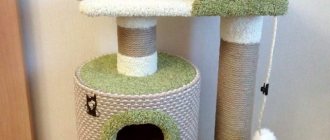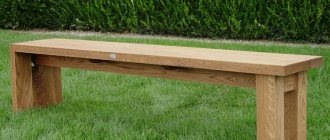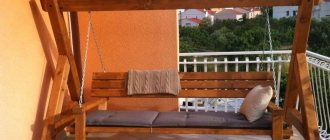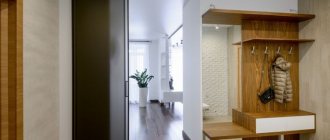Decorating a newly built gazebo is perhaps the most “delicious” activity! All the most difficult construction work is left behind. Arranging the interior space is much easier, more pleasant, and you can fully show your creative streak.
The combination of stone and dark wood looks very consistent! The stone-lined floor with direct access to the garden area prevents the natural harmony from being disturbed.
Gazebo in a marine style
For people who are passionate about the sea, the gazebo should be built on the principle of a light, open canopy, where instead of walls there will be curtains made of organza, on the ceiling there will be straw, reeds or soft tiles, and the floor will be covered with floor tiles made of stones and shells.
The design of a gazebo in a marine style involves:
The classic color combination is blue and white, interspersed with red, yellow and beige.
The presence of elements of marine paraphernalia: porthole windows, sections of ropes, sea knots, fishing nets, etc.
Selecting furniture for a sea gazebo is not so difficult. Just choose a pair of wicker chairs with soft colored pillows, hang a hammock, and place a chest with metal rivets in the corner.
Near the gazebo, the recreation area will be perfectly complemented by a wide umbrella, rocking chair or chaise lounge.
You can emphasize the marine theme around the gazebo with the help of sand, hedges and palm-shaped plants: Hamedorea Seifritz, Livistona chinensis.
Beautiful gazebos in Asian style
The definition of “Asian” includes garden houses made in Japanese and Chinese styles. Both styles are similar, and in some cases they can be easily confused. This is due to the fact that Japanese architecture contains a large number of borrowings from Chinese.
Chinese style in the design of beautiful garden gazebos
When building a gazebo, greater emphasis should be placed on the roof, which is the hallmark of the Chinese style and makes it recognizable. It can be four- or hexagonal, single- or two-tiered. And be sure to have the edges curved up. This ensures that the house resembles a pagoda, a beautiful temple building originally from China.
Please note: the traditional design includes images of dragons, as well as lanterns decorated with red tassels. Furniture is selected wooden, natural or black
The following photo of a Chinese-style gazebo is a classic example of a beautiful roof structure and its design.
Chinese gazebo has a pagoda-shaped roof
Japanese style design
As stated above, Japanese architecture has many borrowings from Chinese. In particular, the pagodas with their characteristic beautiful roofs. Therefore, a Japanese-style gazebo will also have such a roof. But the building itself is designed differently.
Japanese culture is characterized by restraint in everything, including architecture. Straight lines, smooth surfaces, lack of bright colors - this is how a beautiful Japanese gazebo should be. It is usually built from wood, which is colored black, brown or dark cherry.
Photo of Japanese style gazebo design
Decor – minimum. For example, in the previous photo, decorative grilles for the gazebo installed near the load-bearing supports are used as decorations. Additionally, the building can be decorated with smooth linen curtains. It is better to choose smooth furniture, made of beautiful dark wood, with pillows thrown on it to match the curtains. And as outdoor decorations, garden lanterns, which can be hung in the corners of the roof or placed under the walls of the garden house, will be a win-win option.
Design of a gazebo at the dacha. You can use beautiful garden lanterns as decoration.
Tree
The most traditional finishing option. Almost any design can be created from this material, it can be painted and such a ceiling looks simply wonderful. In addition, you do not need any special devices or tools for installation, which can be easily done with your own hands.
When choosing what to cover the ceiling of a gazebo located outdoors and paying attention to wood, it is worth considering that it is susceptible to pests and also does not tolerate humidity very well. Therefore, all surfaces collected from this material must be treated with special compounds that will prevent pests from damaging the coating and protect it from exposure to moist air.
Advantages of wooden gazebos
Garden gazebos can be made from logs or solid wood. Both materials have a large number of positive properties. This material is not harmful to health and the environment.
Such a building is much cheaper than one made of brick.
Another advantage is that you can build a wooden gazebo with your own hands, even without special construction skills.
Wood does not heat up in the sun. This will allow you to relax comfortably in a covered gazebo even on the hottest day.
1dce46baaa51aca80ff898c57a8e819b.jpe
An undeniable advantage is the beauty of such a gazebo. A variety of design styles will allow the gazebo to harmoniously fit into the design of any site.
We are building a gazebo in Japanese style. Step by step guide
Before drawing up a drawing of a Japanese gazebo, let's remember the main idea of construction. Our task is to create a quiet and cozy corner in the Japanese style, from which a beautiful view of the garden plot will open. It is better to build a pagoda on a hill. But if you have a flat area and the terrain is not very diverse, you definitely cannot do without a pile foundation.
So, to create a pagoda elevation, you can:
- Install it on several piles.
- Build an additional podium - it is also built on stilts.
In the first case, you will need 4 pine beams with a section of 15x15 centimeters. To calculate the optimal length, you need to know the length of the pillar that will be hidden underground. As well as the planned height of the gazebo (from 250 centimeters). Then both lengths are added together. The resulting value will be the recommended length of pine beams.
In the second case, the area of the canopy podium will be slightly wider than the base. Therefore, in addition to the four main pillars, 5 intermediate ones are installed. One of them is in the center of the podium, four more are between the supporting pillars.
Before installation, each pile must be treated with a good antiseptic. The wood will be reliably protected not only from moisture, but also from insects. The lower end part can be treated with liquid bitumen.
Preparation for pouring the foundation looks like this:
- Clearing the area of debris.
- Removing the fertile layer to a depth of 5-6 centimeters.
- Marking for the foundation.
- Digging recesses for future racks. The bottom of each hole is filled with drainage made of sand, crushed stone, and compacted tightly.
- Installation of racks in recesses, filling with concrete mortar.
- Checking the level of the vertical position of each rack. Then they need to be left until completely hardened.
How to arrange the lower and upper trim?
We present to your attention a ready-made diagram of the pagoda, the roof, and a step-by-step guide for arranging the piping below and above. For the bottom frame, take a beam with a section of 10 x 4 cm. It will become the basis for the podium or be suitable for installing the floor. It all depends on which installation option was chosen - podium or piles.
When a pagoda is built on stilts, the framing is done in the transverse and longitudinal directions. For fastening, bolts (support beam + foundation pillars) and screws (floor beams + support beams) are used.
When installing on a podium, the logs are installed directly on the surface. You will need an edged board with a length of 20 to 25 centimeters. For the flooring, tongue-and-groove wood with a thickness of 2.8 cm or more is taken. Further stages of construction will be the same.
The oriental-style gazebo project involves arranging a frame at the top made of timber, which is attached to the upper ends. At each corner there are overlays made of wooden planks - you will install struts in them. In accordance with the diagram shown in the photo, lintels and roof rafters are installed. A slope is placed on the rafters - without it, installation of the roof is impossible. For the roof dome, a decorative frame is made, based on thin-walled boards. To ensure that the Japanese-style roof is installed correctly, follow the diagram below:
As a finishing material, you can take ordinary lining. Attach 2 wooden strips to each post on both sides. Additional strips are attached at a distance of 30 centimeters. We do not recommend pushing the material too far into the grooves where the canopy forms a bend. After all, with a sharp change in temperature, it can become deformed.
Japanese roofs, walls and other wooden elements are treated with an antiseptic after installation is completed. This will significantly extend the service life of the structure. If you decide to paint the pagoda, use only acrylic paints. It is very convenient to apply them using an air spray.
It is not difficult to complete the composition if you install a curved bridge next to the pagoda and make a stream. Among the plants, it is worth giving preference to irises and camellias, which are traditional for the oriental style. If the climate allows, you can plant sakura. However, any fruit trees will be an excellent addition. Observing the water and surroundings, the cozy atmosphere inside the gazebo, built with your own hands, will contribute to a good rest.
And in conclusion, I want to share a good video that explains in detail the process of building a Japanese-style gazebo:
Nuances to consider when carrying out work
Brick, wood, plastic, timber and stone are used to build gazebos. Wooden structures are especially popular. This is due to the low price, ease of installation, long service life and installation. At the same time, we should not forget about the lack of resistance to moisture.
To prevent the gazebo from being damaged by changes in temperature and water, it is necessary to insulate the flooring, walls and ceiling in a timely manner. If you are not confident in your abilities, you should turn to professionals. Thermal insulation of all elements is one of the most important stages in preparing the gazebo for wintering.
Characteristics ↑
Location
Often we do not pay much attention to the location of the gazebo on our plot, which cannot be said about the Japanese or Chinese.
As a rule, for a gazebo for a Japanese-style dacha (photo below), a picturesque corner is allocated either in the very center of the site, or on a hill that offers the best view. In a small area, it is desirable that from this place you can view the entire territory. For large ones, it is enough to determine a place from which the house and all its surroundings are clearly visible. Its proximity to a fountain or small pool would be very appropriate.
322940842edcb51b0f881f53a3f3af42.jpe
d69d099f7738711924b505d2c4932f43.jpe
The location of the structure is thought out taking into account the direction of the cardinal points. A blank wall is usually oriented to the south. Then the access to the sun will be limited, and it will be cool inside during the day.
For the side walls of the Japanese, as well as the Chinese gazebo, the direction west and east serves as a guide.
Gazebo material
Classic Japanese style involves the use of exclusively natural materials: wood, reed, shoji (as rice paper is called in Japan), bamboo. Of course, it is not possible to reproduce the original technology in all regions of the country. In addition, these materials, for example, dried reed or waxed paper, will last in weather conditions that differ from our regions, say, the middle zone for at least one season. However, it is quite possible to build it from solid wood or stone.
Design features
Note: If desired, the roof design can be somewhat simplified: make it pseudo-two-tiered or give it a concave shape
One way or another, in any case, it is important that the roof of the Japanese-style gazebo (see photo) be more massive than its base.
- Dimensions. For such a design, this parameter is strictly regulated. It is very easy to calculate it even yourself. The floor is completely covered with mats - tatami measuring 190 by 90 cm. The only thing that still needs to be taken into account is that up to 4-6 mats are used on the floor.
- Window openings. They are located either in the lower part of the gazebo, immediately under the eaves in the upper part. The first option is more suitable for true admirers of this style, who, according to the ceremony, seat their guests mainly on the floor. Light penetrates freely through low-lying windows and perfectly illuminates those present. There should be more than six to eight windows in the gazebo. Their oval or round shape is more common. The windows are decorated with bamboo grilles.
A Japanese-style gazebo, in accordance with traditional canons, is equipped with a niche on the inside. In it you can place a strict composition of flowers or scrolls on which calligraphic writing is applied. In the center you can install a hearth on which tea is prepared.
Note: Japanese gazebos have a special purpose - tea ceremonies are held in them. Their entrance is very low and you can only enter through it by bending over.
Color spectrum
The concept of Eastern philosophy affirms the importance of a state of peace and tranquility, so bright colors are not very appropriate when decorating a Japanese-style gazebo. The designers clearly limited the possible color palette: beige, neutral pastel colors or black and white contrast
Considering the Japanese commitment to everything natural, the best option for a wooden structure remains the natural color of the material. In this case, the wood is impregnated with a waterproofing compound and treated with varnish.
Standard types of ceiling finishes
The ceiling design in the gazebo can be made using a standard set of materials. These include painting, whitewashing, wallpapering or polystyrene tiles. But you need to know that before these procedures you need to put the ceiling in order, namely, level it. Thus, its repair can be divided into two stages: preparatory and finishing repairs. The instructions will look like this:
Preparatory stage
Here all the work is done entirely with your own hands. The ceilings in the gazebos should first be prepared. Before leveling the ceiling, you need to do several operations so that the repair does not have to be redone, namely:
- Clean the old coating, be it paint, whitewash, wallpaper or other materials. This can be done using a spatula. After this procedure, the residues are washed off with water.
- Inspect the ceiling for cracks. If there are any, then they need to be sealed. The same is required for joints between slabs. This is done to ensure that extraneous sounds and moisture do not enter the room and that heat is retained.
- After sealing the cracks, the ceiling is primed and leveled with putty. It will make the surface smoother and hide all imperfections.
- After all these procedures, finishing putty is applied to the ceiling, which, after drying, is sanded.
At the very end, it is recommended to prime the ceiling again. After this, it is ready for finishing.
Finishing stage
At this point you can move on to whitewashing and painting the ceiling. At this stage, it is recommended to use high-quality paints that contain fungicidal additives. Firstly, such paint itself will preserve the surface in its original condition for a long time, and secondly, special components will protect the surface from the formation of fungus. You can buy paint that already has the desired shade or, if you don’t have one, paint it in a suitable shade. It is applied with a brush, roller or a special spray gun for painting. If you can’t make a smooth ceiling without stripes, then there is one trick: the initial layer of paint should be applied in the direction that is across the sun. The second layer needs to be painted along the sunlight.
If the choice of ceiling finishing option fell on wallpapering, then it is worth noting that this method is practically no different from wallpapering walls. It’s even simpler, because you don’t need to cut out spaces on pipes or sockets. It is enough to combine the joints with each other.
It is better to cover the ceiling with washable wallpaper or paint it. This choice will save time and money on repairs, because they can simply be washed or painted in a suitable color.
You can also decorate the ceiling with polystyrene tiles. There are also foam options. The tiles may also have a decorative finish. Before laying this material, it is necessary to calculate the center of the ceiling and calculate the location of the first four tiles.
Tiling is done starting from the center of the ceiling. After laying the first four squares, the rest are located close to them. The tiles are secured with special glue or liquid nails. Finish the ceiling by laying the ceiling plinth. It will give a finished look. If desired, it can also be painted in any color.
Features of interior design
Japanese style has its own characteristics that set it apart from other styles. The most important items are listed in the list below.
Gazebo with patio (platform at the entrance)
- Natural materials. You don't have to use bamboo stalks, wax paper or rice straw to truly embrace the spirit of Japanese culture. It is enough to exclude polycarbonate and other polymers, giving preference to wood, stone and high-quality fabrics for curtains.
- Roof with several tiers (turret). This distinctive feature allows you to quickly understand what style a given building belongs to. In most cases, two or three tiers are installed on Japanese structures.
- Neutral, natural and restrained colors. If in Chinese culture it is customary to hang bright lanterns and paint most elements red, then the Japanese are more restrained in these impulses. To maintain an adequate color of the gazebo, it is recommended to limit the treatment of the material with antiseptics - they will perfectly emphasize the natural pattern of the wood.
- Minimalism. Have you ever seen the features of the Provence style? A huge amount of trinkets, wall art and decorative items? So in the Japanese style this is unacceptable. A classic set of furniture and items for eating is quite enough.
- Curtains. To decorate the building, you can use beige and pastel colored fabric. It must be in harmony with the overall design of the structure, so again the color is limited to the natural range.
The style requirements fit perfectly into Russian culture. There is no need to buy expensive elements, everything is limited to budget building materials and decorations. except that the shape of the roof can cause some difficulties, we will talk about this point later.
Do-it-yourself construction
The location for the gazebo in the country should be secluded, away from noisy streets, in the shade of trees, with beautiful views of the surrounding landscape. It is advisable to have a stream or at least a decorative fountain nearby - the sound of flowing water helps to relax.
Please note that such a structure, according to Eastern culture, must be oriented to the cardinal points:
- the blank wall should be facing north or south - this will help keep you cool in the summer heat;
- the side walls and entrance are oriented to the west or east, allowing you to enjoy views of sunset and sunrise.
To build a gazebo with your own hands, you will need tools that make working with wood easier and faster. It is advisable to have on hand:
- circular and vertical band saws;
- milling and jointing machines;
- surface planer
However, if you have the desire and perseverance, you can build a gazebo in the Japanese style using hand carpentry and carpentry tools. You must have the appropriate skills.
fda0f5b9048879a64d4354d3b14dfb66.jpe
Having selected a suitable drawing, decide in advance on the dimensions, quantity of materials, and calculate the costs. You can build hexagonal or even octagonal structures, although it is easier for beginners to start with a square or round shape.
Suitable materials:
- smooth, processed logs or wide timber as support pillars;
- hardwood timber 10–15 cm thick for walls;
- roof boards;
- suitable roofing material.
Base
First, the area is prepared:
- The site is cleared of debris, stones and tree roots.
- Remove the top turf to a depth of 30 cm to prevent weed growth.
- According to the drawing, markings of the future structure are applied.
- Pegs are installed in the corners, marking the location of the support posts.
You can get by with a lightweight foundation; wood is a lightweight material. Columnar or pile type is suitable. To bookmark:
- Holes are made in the ground and the bottom is covered with a sand cushion.
- The pillars are installed in such a way that they rise above the ground by 30 cm or more, the gazebo should seem to “float” in the air.
- The pits with support columns are concreted.
The area around can be paved with stone or paving slabs.
Wall frame
When the concrete hardens, a lower frame made of solid timber is installed on the supports. Next, the timber for the walls is mounted vertically on the harness. For convenience, the floor boards can already be laid out along the bottom frame - this will make it more convenient to walk, and the frame will be assembled faster.
Having secured the wall beam strictly vertically and fastened it with lags, the top trim is mounted on top. It will secure the walls and serve as the basis for a multi-tiered roof.
Roof
The roof tiers are installed by laying pre-prepared boards. The effect of raising the corners is achieved by filing the boards installed at the edges. By giving them some rounding, it is possible to obtain the required Japanese flavor.
The tiers are firmly fixed to each other. Each subsequent one is made smaller.
Having collected the required number of tiers (usually two are enough), they are covered with boards on top. Next, the material is painted and then covered with soft tiles. The topmost tier is covered first, followed by all the lower ones in turn.
The skate can be made from chopped petals.
Upon completion, they begin laying the flooring, leaving minimal gaps for water drainage. If desired, a plinth for a barbecue oven is laid out in the center and built from bricks, then decorated with stylized tiles. Now it will be possible to organize a traditional Japanese tea party in the gazebo.
Floor boards are painted dark red and varnished.
Decor
Under the ceiling, lamps in the form of traditional Japanese lanterns will look appropriate. Two pieces are enough for lighting. The walls are decorated with tulle curtains, or another option is to cover them with rice paper.
In the depths of the structure, it is advisable to organize a niche in which suitable oriental decoration is placed:
- strict composition of flowers;
- a scroll with picturesque drawings;
- calligraphic writing.
The owners will receive an excellent oasis of peace and serenity.
Where to install a Japanese gazebo in the garden?
Japanese gardens are full of gazebos and wooden bridges. Usually a gazebo is installed in the wilderness, among bushes and trees. Most often, a pedestrian bridge or narrow path leads to a small gazebo or cottage where you can relax in comfort. The designs are simple and wooden, Japanese style, elegant yet modern. Japanese gardens provide a unique atmosphere where you can easily relax and admire the surrounding nature. This garden is usually very green, a color associated with puberty and harmony.
Can you create a Japanese garden around your home? It all depends on the size of your backyard. Very often, a substitute for Japanese arrangement is planting asters, peonies, several shrubs, such as rhododendrons, and a pond with stones. You can also create a path to the gazebo, which is sure to create the atmosphere of a stylish Japanese garden. For decoration, you can also use cast iron lanterns to illuminate the location at night. It is worth choosing an odd number of decorative elements, since asymmetrical systems are characteristic of Japanese gardens.
Walling
After the foundation of the building is completed, it is necessary to build the frame structure and walls. An excellent example of construction is a round model with a dome.
- It is necessary to install a couple of beams from beams (up to 8 pieces) with any cross-section. The design should look like a circle.
- After installing the frame structure, you will need to connect the beams. For this you can use both beams and boards. You can also use other materials for work, for example, wicker.
It's all about energy
I wonder why the Chinese and Japanese chose this particular form? Don’t rush to look for the reason in the individual style and creativity of medieval designers. China and Japan belong to areas with increased seismic activity. Therefore, all buildings being erected must be resistant to earthquakes.
But how to achieve high roof strength? If you look at a Chinese pagoda from the inside, it has a support in the center - a load-bearing pillar. It is attached at depth, making the roof look like an ordinary umbrella. A seemingly simple solution has saved more than one Chinese house from tremors and destruction.
However, there is another reason why the Chinese-style roof acquired its characteristic curved shape. According to Eastern philosophy, straight lines contribute to the penetration of negative energy into the house. To “deceive the spirit” and direct it along a different path, it is enough to change the trajectory of the roof. That is, lift it slightly and turn the corners into a labyrinth. This is an alternative version of how the pagoda came to be. It turns out that the main calling card of Asia is a trap for uninvited guests. It transforms bad energy into positive energy, creating harmony in the house and around it.
Gazebos in Art Nouveau style
Continuing the conversation about the classic styles of gazebos, let's look at a bright representative of the classics - modern.
The aesthetics of curved lines and the desire for constructiveness can be called the main features of the style. In Art Nouveau style gazebos, it is impossible to say where the decor begins and the structure ends, where the plane of the wall turns into sculpture, and the sculpture into the window frame. In the design of gazebos of this type, moving plant patterns and elegant linear metal weaving scattered on the floor, ceiling and walls will always be appropriate.
1056d8e0ebf20ad3fa9b206ff1a7ede9.jpe
3a991fec60c49ac0b055b0fb11235607.jpe
Forging is an important element of a gazebo, stylized as Art Nouveau.
A glass gazebo also meets the general concept of the style.
What you need to know to create a stylish and beautiful gazebo
Every beautiful gazebo, whether it is located in a country house and you use it only in the warm season and on weekends, or whether it is located in the garden of a private house, must harmoniously combine content and idea. The idea is the form, the material from which the construction, style, and decorations are made. The content is responsible for functionality, practicality and convenience, and includes interior design: furniture, textiles, lighting.
In the photo there is a gazebo-turret in the Ukrainian style, a thatched roof and a wattle parapet - characteristic features of the design
A gazebo is an integral architectural element of landscape design, which should delicately fit into the design of the site and echo the design of the main house. There are two types of buildings - closed and open. They are made from stone, wood, brick, metal, and even from climbing plants, shrubs and trees. And in addition, modern gazebos can be of different shapes: rectangular, multifaceted, round, combined, and at the same time differ in the type of roof: domed, hipped, single-pitched and multi-pitched, conical, etc.
The simple design of the gazebo is complemented by beautiful vegetation - this is both decoration and protection from the wind and sun
Round buildings, the basis of which are columns (concrete, stone, wood, iron), topped with a dome, have the beautiful name rotunda. And an elongated gazebo, with light lattice walls, or without them at all, under a vaulted or straight roof is called, in the French manner, a belvedere. And if the same gazebo is glazed on all sides or covered with blank walls, then it will already be a pavilion. There are also tea houses, oriental-style tents, covered Laplanders - grill houses that came from Finnish culture.
Gazebo in the style of a Russian hut, the design complements the decoration with wood carvings
Frame covering
Polycarbonate is best suited for this design. At the same time, if the gazebo is seasonal, then the walls may not be sheathed at all. The materials are relatively inexpensive, but such savings will not be superfluous.
Only the roof and the lower part of the walls can be sheathed.
To do this, transverse jumpers are placed between two adjacent posts, at a height of about 60-70 cm. It is this lower part that is sheathed.
Before sheathing a metal gazebo, you need to cut the polycarbonate sheets. This can be done with a jigsaw or grinder at low speeds.
Gazebo made of profile pipe completely covered with polycarbonate
The polycarbonate is fastened with special self-tapping screws, or in our case, with bolts with thermal washers.
By the way, a welded metal gazebo will be assembled in exactly the same way.
What are the benefits of Japanese gazebos?
Traditionally, Japanese-style gazebos are built using materials such as bamboo, reeds, oiled rice paper and straw for roofing. Unfortunately, the local climate is too harsh for such fragile materials, so domestic buildings in the oriental style are made of stone or wood.
Features of Japanese-style gazebos:
The building must be strictly oriented to the cardinal points. So, a blank wall is made on the south side, and the entrance to the pagoda is located on the west or east
This design ensures constant coolness inside the building and helps you fully enjoy the beauty of sunsets and sunrises. Not only the style of the gazebo is important; the Japanese pay great attention to the area surrounding the pagoda. It is better to build a Japanese house on a small hill so that it is better visible from all sides of the site
It is recommended to plant evergreen shrubs, dwarf trees, and plants with large and bright flowers (peonies, lilies, chrysanthemums) around the pagoda. If possible, you can follow the example of the Japanese themselves and surround the holiday house with fruit trees or traditional sakura. It’s good if there is a natural or artificial pond not far from the pagoda. Contemplation of water promotes better relaxation - after relaxing in such a gazebo, you can feel like a real Japanese: calm and calm. A distinctive feature of Japanese gazebos is their multi-tiered roof, the so-called pagoda. The building itself should be minimalistic and simple, but much more attention is paid to the roof - the more magnificent and complex it is, the more spectacular the entire gazebo. The corners of the roof should be raised, which creates the effect of a floating, airy building. A Japanese gazebo is often built on stilts, which makes it even more weightless. A light curved bridge with graceful steps will help to emphasize the oriental style. For decoration, do not use flashy shades and colorful fabrics; priority is given to pastel or neutral colors, plain textiles or mats.
Safety first
When cooking on a grill indoors, you must follow the safety rules and precautions:
Never touch the metal elements of the grill while cooking to avoid the risk of burns.
Keep children away from the grill while it is in operation and do not allow them to cook their own food.
Do not pour liquid into a burning barbecue, otherwise there is a risk of steam burns.
After cooking, do not empty the coal into the trash can. It can still smolder for three days.
Be sure to organize a stand with equipment for extinguishing a fire indoors, or at least place a fire extinguisher in the gazebo.
Looking at the photo of the finished closed gazebo, we can safely conclude that this is an ideal place for outdoor recreation.
You always have the opportunity to cook delicious dishes on the grill in the fresh air, regardless of the weather, and also relax and unwind in the company of your closest people.
Be sure to organize a cozy and comfortable recreation area if your capabilities allow.
Self-discovery through communication with nature
In order to be in harmony with yourself, you need to look for points of contact with nature. The perception of the world in Japanese culture is expressed in a sense of beauty and a desire to admire, and sometimes worship and deify every natural phenomenon. Japanese gardens are a special philosophy of Japanese life. The owner's gardens are filled with his soul.
The tea drinking procedure in Japan is a special cult that combines elements of architecture, painting, and landscape art. The tea ceremony embodies the unity of perception of the surrounding nature, creativity, philosophical mood and communication. In Japan, the ritual of the tea ceremony has been taking place for centuries in small houses, which are located in shady gardens far from the existing bustle of surrounding life.
Modern man, having a country plot, finds in it unity with nature.
By giving the site a Japanese style, he will be able to come into at least a little contact with the principles of Japanese philosophy:
- the principle of harmony carries the concept of the unity of man with nature;
- the principle of respect reflects equality and respect for each other;
- the principle of purity is the purification of the human soul through the knowledge of beauty.
To get to know yourself and the world around you, you don’t need much - just put a small Japanese gazebo house on your property and stylize it in an oriental style for holding tea ceremonies and having a wonderful time communicating with loved ones. Around the gazebo, it is necessary to provide an island of nature with an amazing bridge and a stream or a small fountain, as well as arrange garden paths that will decorate the landscape of the site. Blooming flowers and climbing plants, planted by the owner's hands, will remind you of the flavor of Japan.
In the next video you will find a review of a cute Japanese-style gazebo.
b6b2640358c66a3984d5bc0efa0745a3.jpe
b4936c9f9fcf95053aceaa6a7ac5b289.jpe 6567292bebd0d4fe3851ebc297514ec4.jpe
Japanese gazebo: choosing materials for construction
Oriental-style buildings, including Japanese gazebos, exclude the use of artificial materials and focus on the use of natural finishing materials. Such architectural landmarks are extremely common in the Land of the Rising Sun. The following finishing materials are traditionally used:
- Wood;
- Bamboo;
- Cane;
- Rice and oiled paper;
However, when choosing materials, it is not enough to focus only on their naturalness. In addition, it is necessary to take into account the climatic zone in which your eastern building will be located, and taking this into account, decide on the materials used. Classic Japanese materials in the middle zone are short-lived: the reed will undergo deformation and become damp, as for partitions made of oiled paper, they will simply be torn by the wind. Therefore, in our case, we will prefer natural stone and hardwood, which can withstand the onslaught of harsh climatic factors. But not everything is so simple here either.
Having made a choice of natural stone for the floor, it is important to remember that, despite its stability, it can be destroyed under the influence of severe frosts, and also overheats greatly in the sun. Therefore, many people prefer natural stone.
If in your climate zone stone is the only material suitable for use, when building a Japanese pagoda gazebo, it is necessary to equip a massive and reliable foundation.
When using wood, it is important to carry out high-quality treatment of the material with an antiseptic; in this case, the building can last for many years
Criterias of choice
Before you start choosing furniture for your gazebo, you should study as much information as possible about such sets. Depending on their purpose and operating characteristics, they are divided into several groups. When considering certain options, it is important to consider a number of factors:
- Place of operation. If there is an open gazebo on the site, it is recommended to furnish it with furniture intended for the street. Such headsets are made from durable, wear-resistant materials that are resistant to temperature changes, exposure to sunlight, rain, and snow. Closed gazebos can be furnished with any furniture.
- Purpose. Most sets are intended exclusively for relaxation, and therefore require the presence of a table, chairs, and benches. If you plan to cook food in the gazebo, you should take a closer look at sets equipped with additional elements (work surfaces, drawers for storing food, dishes). Some kits are also designed to accommodate all kinds of garden accessories and tools.
- Design. Depends on how often the owners are on the site. If visiting the dacha is carried out only in spring and summer, the best option would be prefabricated furniture that can be easily transported. If the house is lived in year-round, the gazebo can be equipped with built-in products.
- Nature of production. Modern furniture is classified taking into account the characteristics of its manufacture. It can be mass, individual, experimental, exclusive.
- Completeness. Tables, chairs, benches, sun loungers can be purchased individually or take a closer look at the sets. In both cases, products are selected taking into account the general style of the gazebo.
Advantages of garden furniture made of artificial rattan, primary colors
In order not to make a bad choice, owners need to think in advance about exactly how the gazebo will be equipped and how it will be used. You need to decide which pieces of furniture will be placed where and how. It is also important not to lose sight of the need to perform preliminary measurements of the dimensions of the room.
The minimum set for a gazebo is a table, a couple of chairs. Depending on the area of the room and the features of use, it is possible to place sun loungers, benches, work surfaces, and pencil cases with shelves.
